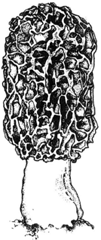Morels and Truffles
Although most mushrooms used as food belong to Basidiomycetes, several belong to Ascomycetes. Such is the case with morels and truffles. Morchella esculenta is highly regarded for its delicate flavor. These mushrooms have been esteemed since ancient times. Plutarch (c. 46-after 119) thought they were produced by thunder. Eating them can present certain hazards, however. Specifically, some people have been adversely affected when consuming morels along with alcoholic beverage. The fruiting bodies of morels are not like those of most ascomycetes. Rather than being cup- or saucer-shaped, the apothecium appears to be turned inside out, with the asci borne in depressions on the surface of a cap. Morels have not been successfully grown commercially. |
| Figure 19-9 Morchella esculenta (Illustration by burette Richin) |
Truffles produce fruiting bodies underground. While these mushrooms are a highly regarded delicacy, special skills are required to locate them. The unmatched experts for locating them are dogs and pigs trained to detect the mushrooms by odor. When unearthed, the master must quickly step forward. No part of this fungal treasure can go to the pig-not at $145.00 per ounce! The reward, instead, are acorns carried in the master’s pocket. There are some people who have well-trained noses and thus do not need to rely on trained animals. Truffles are found in Oregon and California; but the best known sites are in the south of France, where oak forests are preserved primarily for truffle hunting. The truffle ascocarp is entirely enclosed. The only apparent means of spore dispersal is consumption of the fruiting bodies on the part of certain animals (mostly rats). The spores pass through the animal’s body unaltered.




